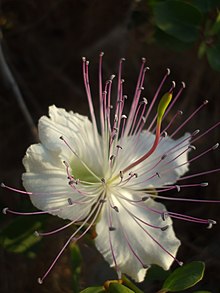Herogamy

As herkogamy or Getrenntzwittrigkeit in which is Botany the spatial separation of male and female sexual organs within a flower called or on different individuals. This serves to avoid self-pollination and to promote cross- pollination . Herogamy as a mechanism represents an alternative to the dikline , i.e. the formation of separate-sex flowers.
In most cases, is herkogamy scar in the approach path of the flower visiting insect, so from another flower of brought pollen is unloaded here before the stamens of new pollen is taken. Anatomically, this can be achieved by greatly lengthening the stylus or by lifting the entire gynoeceum with a gynophore , an extension of the flower axis. With some plant species such as the juggler flower ( mimulus ), herogamy is associated with a movement triggered by touch ( thigmonasty ), which closes the scar after visiting an insect or moves it out of the approach path, so that pollination is prevented when the insect takes off.
There are several different forms of herogamy:
- on approach, approached; Scar is higher than the anthers
- reverse (reverse); Scar is deeper than the anthers
- homomorphic; all flowers in the same shape and hermaphroditic; ordered or disordered.
- interfloral; some or all of the flowers have only one function. ( Monocy , Diocy , Sub-Diocy )
- Another form is reciprocal herogamy (reciprocal), this includes enantiostyly (crookedness) and heterostyly in which flowers of different shapes occur within a species, whereby in one type the positions of the male and female genital organs are reversed compared to the other, so that pollen deposited on the insect in one type of flower only comes into contact with the stigma in the other type.
A distinction can also be made between:
- ordered; correct arrangement in relation to pollinator access, flower morphology controls pollinator.
- disordered; the contact of the pollinator is not ordered, does not follow any sequence.
- temporary, partial dichogamy ; Scars and pollen, or both, appear in the same location at different times. For example, the movement of the stamens allows them to take a position at the time of pollen release that corresponds to the position of the receptive, receptive stigmas on older (or younger) flowers, and a different position during the female phase.
- movable (movement); the flower parts move in relation to the pollinator, e.g. B. the stigmas close on contact or when pollen reaches them, or the stamens move inward when the pollinator touches the stigma (trigger, hercogamy).
literature
- Peter Leins, Claudia Erbar: Blossom and Fruit. Aspects of morphology, evolutionary history, phylogeny, function and ecology . Schweizerbart, Stuttgart 2000, ISBN 3-510-65194-4 , pp. 145-151 .
Individual evidence
- ^ A b Peter K. Endress: Diversity and Evolutionary Biology of Tropical Flowers. Cambridge Univ. Press, 1996, 1998, ISBN 0-521-42088-1 , pp. 194 f.
- ↑ Pat Willmer: Pollination and Floral Ecology. Princeton Univ. Press, 2011, ISBN 978-0-691-12861-0 , p. 74.
- ^ Gurcharan Singh: Plant Systematics: An Integrated Approach. Third Edition, CRC Press, 2010, ISBN 978-1-4398-4363-5 , p. 132.